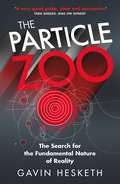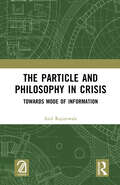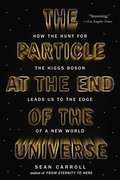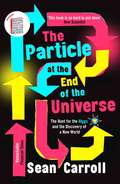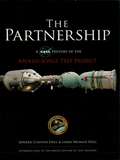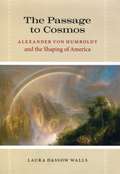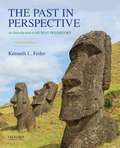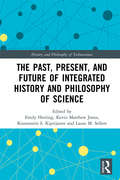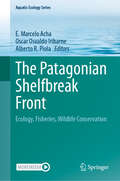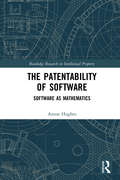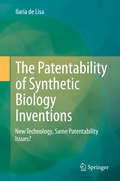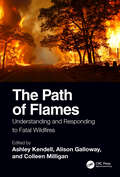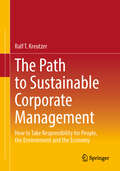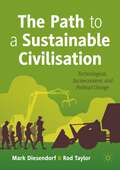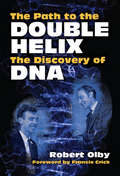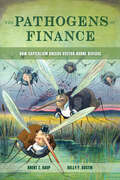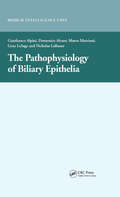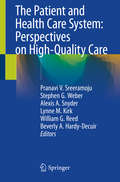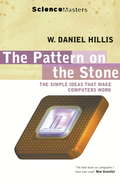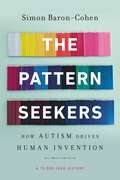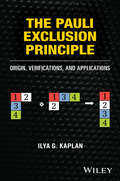- Table View
- List View
The Particle Zoo: The Search for the Fundamental Nature of Reality
by Gavin HeskethWhat is everything really made of? If we split matter down into smaller and infinitesimally smaller pieces, where do we arrive? At the Particle Zoo - the extraordinary subatomic world of antimatter, ghostly neutrinos, strange-flavoured quarks and time-travelling electrons, gravitons and glueballs, mindboggling eleven-dimensional strings and the elusive Higgs boson itself.Be guided around this strangest of zoos by Gavin Hesketh, experimental particle physicist at humanity's greatest experiment, the Large Hadron Collider. Concisely and with a rare clarity, he demystifies how we are uncovering the inner workings of the universe and heading towards the next scientific revolution.Why are atoms so small? How did the Higgs boson save the universe? And is there a Theory of Everything? The Particle Zoo answers these and many other profound questions, and explains the big ideas of Quantum Physics, String Theory, The Big Bang and Dark Matter... and, ultimately, what we know about the true, fundamental nature of reality.
The Particle Zoo: The Search for the Fundamental Nature of Reality
by Gavin HeskethWhat is everything really made of? If we split matter down into smaller and infinitesimally smaller pieces, where do we arrive? At the Particle Zoo - the extraordinary subatomic world of antimatter, ghostly neutrinos, strange-flavoured quarks and time-travelling electrons, gravitons and glueballs, mindboggling eleven-dimensional strings and the elusive Higgs boson itself.Be guided around this strangest of zoos by Gavin Hesketh, experimental particle physicist at humanity's greatest experiment, the Large Hadron Collider. Concisely and with a rare clarity, he demystifies how we are uncovering the inner workings of the universe and heading towards the next scientific revolution.Why are atoms so small? How did the Higgs boson save the universe? And is there a Theory of Everything? The Particle Zoo answers these and many other profound questions, and explains the big ideas of Quantum Physics, String Theory, The Big Bang and Dark Matter... and, ultimately, what we know about the true, fundamental nature of reality.
The Particle and Philosophy in Crisis: Towards Mode of Information
by Anil RajimwaleThis book is a novel study on the way revolutions in science, technology and communication impact philosophy/world outlook including Marxism, society's future, mode of production, capitalism/socialism dichotomy, world economy, and trends like postmodernism and post-industrialism. It also deals with motion of and crisis created by the new concept of 'the particle' on human thought, philosophy and worldview. We ride the unprecedented scientific and technological revolution (STR) into the 'unlighted' extra-ordinary world of quantum motions. Human thought and being are shifting to and gathering speed along the time paradigm, rendering dialectics increasingly crucial, the book opines. Electronic technology, quantum discoveries and wave/particle duality as a wonder of nature have changed forever the way we look at 'the world', which stands redefined. Grounds of philosophy move away, creating epistemological crisis as we transit to a post-classical world. We now look at whole humanity from out in the space, and our dialectics and contradictions acquire new meaning. This self-transcendence can potentially free us of existing acute contradictions. Scientific literature and sources have then been creatively used in the book to take up the concepts of matter, idea, motion, time, space and dialectics. It is therefore a bold attempt to negate the existing philosophy by creatively developing a new scientific world outlook.
The Particle at the End of the Universe: How the Hunt for the Higgs Boson Leads Us to the Edge of a New World
by Sean CarrollScientists have just announced an historic discovery on a par with the splitting of the atom: the Higgs boson, the key to understanding why mass exists has been found. In The Particle at the End of the Universe, Caltech physicist and acclaimed writer Sean Carroll takes readers behind the scenes of the Large Hadron Collider at CERN to meet the scientists and explain this landmark event. The Higgs boson is the particle that more than six thousand scientists have been looking for using the Large Hadron Collider, the world's largest and highest energy particle accelerator, which lies in a tunnel 17 miles in circumference, as deep as 575 feet beneath the Franco-Swiss border near Geneva. It took ten years to build and this search has now cost over $9 billion and required the collaboration of engineers from more than one hundred countries. What is so special about the Higgs boson? We didn't really know for sure if anything at the subatomic level had any mass at all until we found it. The fact is, while we have now essentially solved the mass puzzle, there are things we didn't predict and possibilities we haven't yet dreamed. A doorway is opening into the mind boggling, somewhat frightening world of dark matter. We only discovered the electron just over a hundred years ago and considering where that took us--from nuclear energy to quantum computing--the inventions that will result from the Higgs discovery will be world-changing. The Particle at the End of the Universe not only explains the importance of the Higgs boson but also the Large Hadron Collider project itself. Projects this big don't happen without a certain amount of conniving, dealing, and occasional skullduggery-- and Sean Carroll explores it all. This is an irresistible story (including characters now set to win the Nobel Prize among other glories) about the greatest scientific achievement of our time.
The Particle at the End of the Universe: The Hunt for the Higgs and the Discovery of a New World
by Sean CarrollWinner of the 2013 Royal Society Winton Prize for Science Books It was the universe's most elusive particle, the linchpin for everything scientists dreamed up to explain how physics works. It had to be found. But projects as big as CERN's Large Hadron Collider don't happen without incredible risks - and occasional skullduggery. In the definitive account of this landmark event, Caltech physicist and acclaimed science writer Sean Carroll reveals the insights, rivalry, and wonder that fuelled the Higgs discovery, and takes us on a riveting and irresistible ride to the very edge of physics today.
The Partnership: A NASA History of the Apollo-Soyuz Test Project (Dover Books on Astronomy)
by Paul Dickson Edward Clinton Ezell Linda Neuman EzellThe 1975 Apollo-Soyuz Test Project (ASTP) was the first joint U.S.-Soviet space flight, in which teams from the two nations met in orbit to test an international docking system and conduct both collaborative and independent studies. Although primarily a symbol of international goodwill, the mission provided useful experience for future cooperative ventures between the two nations. This authorized NASA history features many fascinating interviews with participants as well as firsthand observations of ASTP activities.Because details of the Soviet space program remained shrouded in secrecy during the ASTP, the story is told from the American perspective. No scientific background is necessary to appreciate the narrative, which focuses on the participants' working relationships rather than the technical aspects of their jobs. Starting with the early years of the Cold War competition, it traces the formation of an alliance between NASA and Soviet Academy engineers in developing a test project, training the crew, and the triumphant flight. Eighty-six pages of photographs include twelve full-color pages with images of Earth from space.
The Passage to Cosmos: Alexander Von Humboldt and the Shaping of America
by Laura Dassow WallsHumboldt espoused the idea that, while the universe of nature exists apart from human purpose, its beauty and order, the very idea of the whole it composes, are human achievements: cosmos comes into being in the dance of world and mind, subject and object, science and poetry.
The Past In Perspective: An Introduction To Human Prehistory (Seventh Edition)
by Kenneth L. FederIdeal for introduction to archaeology and world prehistory courses, The Past in Perspective: An Introduction to Human Prehistory, Seventh Edition, is an engaging and up-to-date chronological overview of human prehistory. <P><P>Kenneth L. Feder introduces students to "the big picture"--the grand sweep of human evolutionary history--presenting the human past within the context of fundamental themes of cultural evolution. Feder's unique, refreshing, and accessible narrative personalizes the past and makes it relevant to today's students. <P><P>Using a consistent chapter format--"Prelude, Chronicle, Issues and Debates, Messages from the Past, and Case Study Close-up"--Feder helps students master both what we know and what is still debated about the complex story of the human past.
The Past, Present, and Future of Integrated History and Philosophy of Science (History and Philosophy of Technoscience)
by Emily Herring Kevin Matthew Jones Konstantin S. Kiprijanov Laura M SellersIntegrated History and Philosophy of Science (iHPS) is commonly understood as the study of science from a combined historical and philosophical perspective. Yet, since its gradual formation as a research field, the question of how to suitably integrate both perspectives remains open. This volume presents cutting edge research from junior iHPS scholars, and in doing so provides a snapshot of current developments within the field, explores the connection between iHPS and other academic disciplines, and demonstrates some of the topics that are attracting the attention of scholars who will help define the future of iHPS.
The Pasteurization of France
by Bruno LatourWhat can one man accomplish, even a great man and brilliant scientist? Although every town in France has a street named for Louis Pasteur, was he alone able to stop people from spitting, persuade them to dig drains, influence them to undergo vaccination? Pasteur’s success depended upon a whole network of forces, including the public hygiene movement, the medical profession (both military physicians and private practitioners), and colonial interests. It is the operation of these forces, in combination with the talent of Pasteur, that Bruno Latour sets before us as a prime example of science in action. Latour argues that the triumph of the biologist and his methodology must be understood within the particular historical convergence of competing social forces and conflicting interests. Yet Pasteur was not the only scientist working on the relationships of microbes and disease. How was he able to galvanize the other forces to support his own research? Latour shows Pasteur’s efforts to win over the French public—the farmers, industrialists, politicians, and much of the scientific establishment. Instead of reducing science to a given social environment, Latour tries to show the simultaneous building of a society and its scientific facts. The first section of the book, which retells the story of Pasteur, is a vivid description of an approach to science whose theoretical implications go far beyond a particular case study. In the second part of the book, “Irreductions,” Latour sets out his notion of the dynamics of conflict and interaction, of the “relation of forces.” Latour’s method of analysis cuts across and through the boundaries of the established disciplines of sociology, history, and the philosophy of science, to reveal how it is possible not to make the distinction between reason and force. Instead of leading to sociological reductionism, this method leads to an unexpected irreductionism.
The Patagonian Shelfbreak Front: Ecology, Fisheries, Wildlife Conservation (Aquatic Ecology Series #13)
by E. Marcelo Acha Oscar Osvaldo Iribarne Alberto R. PiolaThis book provides a compilation of basic information on the topic of the Patagonian Shelfbreak front, but integrally reanalyzes this under modern paradigms. The book provides a synthesis of the ecosystem characteristics, encompassing physical and chemical oceanography, plankton, nekton and benthos communities, fisheries and conservation issues. It provides hypothesis to guide future research, and recommendations for policymakers and stakeholders. Fronts play key roles in marine ecosystems, and shelfbreak fronts are ubiquitous elsewhere in the world ocean, broadening the interest of our proposal. The Patagonian shelfbreak front is a hot spot of marine life, with several associated fisheries and intensive use by marine birds and mammals. This book will contribute to fill the information gap of the Southwestern Atlantic, a region where there is a growing interest in terms of conservation and management actions. Its primary audience are researchers and postgraduate students, being also relevant for conservation scientists and resource managers.
The Patentability of Software: Software as Mathematics (Routledge Research in Intellectual Property)
by Anton HughesThis book explores the question of whether software should be patented. It analyses the ways in which the courts of the US, the EU, and Australia have attempted to deal with the problems surrounding the patentability of software and describes why it is that the software patent issue should be dealt with as a patentable subject matter issue, rather than as an issue of novelty or nonobviousness. Anton Hughes demonstrates that the current approach has failed and that a fresh approach to the software patent problem is needed. The book goes on to argue against the patentability of software based on its close relationship to mathematics. Drawing on historical and philosophical accounts of mathematics in pursuit of a better understanding of its nature and focusing the debate on the conditions necessary for mathematical advancement, the author puts forward an analytical framework centred around the concept of the useful arts. This analysis both explains mathematics’, and therefore software’s, nonpatentability and offers a theory of patentable subject matter consistent with Australian, American, and European patent law.
The Patentability of Synthetic Biology Inventions: New Technology, Same Patentability Issues?
by Ilaria de LisaThis book addresses Synthetic Biology (SynBio), a new and promising biotechnology that has attracted much interest from both a scientific and a policy perspective. Yet, questions concerning the patentability of SynBio inventions have not been examined in detail so far; as a result, it remains unclear whether these inventions are patentable on the basis of current norms and case law. The book addresses this question, focusing especially on the subject matter’s eligibility and moral criteria. It provides an overview of the legislation and decisions applicable to SynBio patents and examines this new technology in view of the ongoing debate over the patentability of biotechnologies in general. The legal analysis is complemented by the practical examination of several patent applications submitted to the European and US patent offices (EPO and USPTO), and by an assessment of the patent issues that are likely to be raised by future SynBio developments.
The Path of Flames: Understanding and Responding to Fatal Wildfires
by Alison Galloway Ashley Kendell Colleen MilliganThe Path of Flames: Understanding and Responding to Fatal Wildfires is an edited volume covering the complexities of response and recovery issues relative to catastrophic wildfires. As wildfires become more frequent throughout the world—and the loss of life greater, especially among residents trapped in the path of the flames—it is essential that agencies in fire-prone areas understand the complexity of the response as it relates to finding and identifying the remains of those who perished. While covering wildfire dynamics, risks for vulnerable populations, and the emergency response to wildfires, this book focuses largely on the recovery of human remains within the context of the overall response to mass disasters resulting from wildfires. As such, search protocols, staffing needs, pre-event coordination and organization, and logistical support are addressed. The scientific basis for understanding how fire will affect human remains—as well as how the level of destruction can be interpreted—is also addressed. Recognizing the multidisciplinary nature of the field, this volume covers forensic issues relating to the recovery of remains, forensic anthropology, DNA analysis, forensic odontology, and forensic pathology. The book also includes contributions from international wildfire response professionals looking at global best practices in wildfire response and human remains recovery. Specifically, several chapters cover the lessons learned from the devasting Camp Fire of 2018 in California that led to the deaths of 85 people. The Camp Fire burned nearly 19,000 structures and was ultimately the most destructive—and deadly—in California’s history. The Path of Flames is a one-of-a-kind reference that serves as a valuable resource for professionals working in the areas of emergency services, search and rescue, law enforcement, fire service, disaster planning and response, victim recovery and identification, and mass disaster and mass fatality response.
The Path to Sustainable Corporate Management: How to Take Responsibility for People, the Environment and the Economy
by Ralf T. KreutzerThis book shows how managers at all levels of the company can master the challenges of sustainable corporate management with confidence. Concrete action plans are presented for this purpose. Climate change and the finite nature of natural resources are already taking their toll worldwide. A rethink towards ecological sustainability is not only urgently needed at a global level. The orientation of corporate strategies is also increasingly determined by the socio-political morals of customers and other stakeholders, where economic and socio-political interests must be in harmony with social and ecological challenges. Using the three-pillar model for sustainability (Triple Bottom Line) and further topics (such as supply chain law and ESG criteria), the author shows in a practical way how companies can successfully meet these major challenges in the long term. The key to success lies in a change in values towards ecological, social and economic sustainability that is defined and practiced at all levels of the company. Nicola Oudejans, Course Director Chief Digital Officer at the University for Continuing Education Krems/Danube University Krems
The Path to a Sustainable Civilisation: Technological, Socioeconomic and Political Change
by Rod Taylor Mark DiesendorfThe Path to a Sustainable Civilisation shows that we have unwittingly fallen into an existential crisis of our own making. We have allowed large corporations, the military and other vested interests to capture governments and influence public opinion excessively. We have created a god called ‘the market’ and allowed our most important decisions to be made by this imaginary entity, which is in fact a human system controlled by vested interests. The result has been the exploitation of our life support system, our planet, and most of its inhabitants, to the point of collapse. This book argues that the way out of our black hole is to build social movements to apply overwhelming pressure on government and big business, weaken the power of vested interests and strengthen democratic decision-making. This must be done simultaneously with action on the specific issues of climate, energy, natural resources and social justice, in order to transition to a truly sustainable civilisation.
The Path to the Double Helix: The Discovery of DNA (Dover Books on Biology)
by Robert OlbyWritten by a noted biology historian, this classic volume provides the first in-depth account of the 1953 discovery of the molecular structure of DNA by James Watson and Francis Crick. Crick himself, who also provided the Foreword, proclaimed that "no future historian of science in this area will be able to ignore this present volume."
The Pathogens of Finance: How Capitalism Breeds Vector-Borne Disease (Critical Environments: Nature, Science, and Politics)
by Brent Z. Kaup Kelly F. AustinThe Pathogens of Finance is an exploration of how the rising power and profits of Wall Street underpin the contemporary increases in and inadequate responses to vector-borne disease. Over the past fifty years, insects have transmitted infectious diseases to humans with greater frequency and in more unexpected places. To examine this phenomenon, Brent Z. Kaup and Kelly F. Austin take readers to the exurban homes of northern Virginia; the burgeoning agricultural outposts of Mato Grosso, Brazil; and the smallholder coffee farms of the Bududa District of eastern Uganda. Through these case studies, the authors illuminate how the broader financialization of society is intimately intertwined with both the creation of landscapes more conducive to vector-borne disease and the failure to prevent and cure such diseases throughout the world.
The Pathologisation of Homosexuality in Fascist Italy: The Case of 'G' (Genders and Sexualities in History)
by Gabriella RomanoThis open access book investigates the pathologisation of homosexuality during the fascist regime in Italy through an analysis of the case of G., a man with "homosexual tendencies" interned in the Collegno mental health hospital in 1928. No systematic study exists on the possibility that Fascism used internment in an asylum as a tool of repression for LGBT people, as an alternative to confinement on an island, prison or home arrests. This research offers evidence that in some cases it did.The book highlights how the dictatorship operated in a low-key, shadowy and undetectable manner, bending pre-existing legislation. Its brutality was - and still is - difficult to prove. It also emphasises the ways in which existing stereotypes on homosexuality were reinforced by the regime propaganda in support of its so-called moralising campaign and how families, the police and the medical professionals joined forces in implementing this form of repression.
The Pathophysiology of Biliary Epithelia
by Gianfranco AlpiniThis book is a comprehensive review of the biliary epithelia pathophysiology. Biliary epithelial cells (also referred to as cholangiocytes) line the intra- and extrahepatic bile ducts. Cholangiocytes have immerged in the last several years as one of the more important epithelial cells in the gastrointestinal system due to their large contribution to bile formation and tendency to be involved in human diseases.The book’s 35 chapters represent a nearly complete review of the function and disease of bile ducts. The gestational development of bile ducts is shown to be a complex interaction between hepatocyte and biliary precursors. The structure of bile ducts can be defined by ultrastructural studies and by 3D reconstruction studies which show that the bile duct system resembles a tree. The array of membrane transporters and channels involved in ductal absorption and secretion of water and electrolytes is reviewed. Like other gastrointestinal epithelial cells, the physiologic responses of cholangiocytes are regulated by hormones, nerve input, cytokines, factors in bile and intracellular signals (e.g., cyclic AMP and intracellular calcium). The potential role of the cholangiocyte in production of collagen in cholestatic liver disease is discussed. A number of important models used in the study of cholangiocyte physiology and reactions to injury are reviewed. Finally the relationships between the cholangiocyte responses and human liver diseases are discussed.While many basic scientists and hepatologists who devote their careers to the study of the liver will find this book useful, the intended audience of this book is the more heterogeneous group of individuals who study clinical and/ or basic science digestive physiology and due to their interest in epithelial function will find the cutting edge information in this book both enlightening and useful to their progression of their work.
The Patient and Health Care System: Perspectives on High-Quality Care
by Pranavi V. Sreeramoju Stephen G. Weber Alexis A. Snyder Lynne M. Kirk William G. Reed Beverly A. Hardy-DecuirThis book focuses on the interface between the patient and the healthcare system as the entryway to high-quality care and improved outcomes. Unlike other texts, this book puts the patient back in the center of care while integrating the various practices and challenges. Written by interdisciplinary experts, the book begins by evaluating the entire quality landscape before giving voice to all parties involved, including physicians, nurses, administrators, patients, and families. The text then focuses on how to develop a structure that meets needs of all of these groups, effectively addressing common threats to positive outcomes and patient satisfaction. The text tackles the most common challenges clinicians face in a hospital setting, including infection prevention, medication error and stewardship that may jeopardize recovery, complex care, and employee-patient engagement.The Patient and Healthcare System: Perspectives on High-Quality Care is an excellent resource for physicians across broad specialties, nurses, hospital administrators, social workers, patient caregivers and all healthcare professionals concerned with infection prevention, quality and safety of care delivery, and patient satisfaction.
The Pattern On The Stone: The Simple Ideas That Make Computers Work (SCIENCE MASTERS)
by Daniel HillisWill computers become thinking machines? A scientist at the cutting-edge of current research gives his provocative analysis.The world was shocked when a computer, Deep Blue defeated Gary Kasparov, arguably the greatest human chess player ever to have lived. This remarkable victory, and other, more day-to-day innovations, beg serious questions: what are the limits of what computers can do? Can they think? Do they learn?Discussions of these questions tend to get muddled because most people have only the vaguest idea of how computers actually work. This book explains the inner workings of computers in a way that does not require a profound knowledge of mathematics nor an understanding of electrical engineering. Starting with an account of how computers are built and why they work, W. Daniel Hillis describes what they can and cannot do - at the present time - before explaining how a computer can surpass its programmer and, finally, where humanity has reached in its quest for a true Thinking Machine.
The Pattern Seekers: How Autism Drives Human Invention
by Simon Baron-CohenA groundbreaking argument about the link between autism and ingenuity.Why can humans alone invent? In The Pattern Seekers, Cambridge University psychologist Simon Baron-Cohen makes a case that autism is as crucial to our creative and cultural history as the mastery of fire. Indeed, Baron-Cohen argues that autistic people have played a key role in human progress for seventy thousand years, from the first tools to the digital revolution.How? Because the same genes that cause autism enable the pattern seeking that is essential to our species's inventiveness. However, these abilities exact a great cost on autistic people, including social and often medical challenges, so Baron-Cohen calls on us to support and celebrate autistic people in both their disabilities and their triumphs. Ultimately, The Pattern Seekers isn't just a new theory of human civilization, but a call to consider anew how society treats those who think differently.
The Pauli Exclusion Principle: Origin, Verifications, and Applications
by Ilya G. KaplanThis is the first scientic book devoted to the Pauli exclusion principle, which is a fundamental principle of quantum mechanics and is permanently applied in chemistry, physics, and molecular biology. However, while the principle has been studied for more than 90 years, rigorous theoretical foundations still have not been established and many unsolved problems remain. Following a historical survey in Chapter 1, the book discusses the still unresolved questions around this fundamental principle. For instance, why, according to the Pauli exclusion principle, are only symmetric and antisymmetric permutation symmetries for identical particles realized, while the Schrödinger equation is satisfied by functions with any permutation symmetry? Chapter 3 covers possible answers to this question. The construction of function with a given permutation symmetry is described in the previous Chapter 2, while Chapter 4 presents effective and elegant methods for finding the Pauli-allowed states in atomic, molecular, and nuclear spectroscopy. Chapter 5 discusses parastatistics and fractional statistics, demonstrating that the quasiparticles in a periodical lattice, including excitons and magnons, are obeying modified parafermi statistics. With detailed appendices, The Pauli Exclusion Principle: Origin, Verifications, and Applications is intended as a self-sufficient guide for graduate students and academic researchers in the fields of chemistry, physics, molecular biology and applied mathematics. It will be a valuable resource for any reader interested in the foundations of quantum mechanics and its applications, including areas such as atomic and molecular spectroscopy, spintronics, theoretical chemistry, and applied fields of quantum information.
